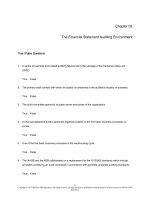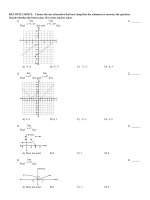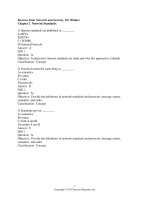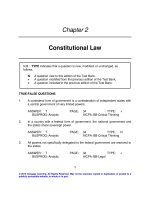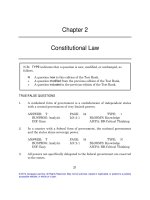Century 21 computer skills and applications lessons 1 90 10th edition hoggatt test bank
Bạn đang xem bản rút gọn của tài liệu. Xem và tải ngay bản đầy đủ của tài liệu tại đây (15.35 KB, 4 trang )
TRUE/FALSE
Indicate whether the statement is true or false.
1.
When you key, your textbook should be placed at the right of the keyboard.
ANS: T
2.
When you key, you should keep your wrists low and slightly touching the keyboard.
ANS: F
3.
You should keep your feet on the floor while you key.
ANS: T
4.
You should hit each key with the full ball of the finger.
ANS: F
5.
The notation DS in your keyboarding textbook means double space or use double spacing.
ANS: T
6.
Space twice after a period at the end of a sentence.
ANS: T
7.
Tap Enter to return the insertion point to the left margin and move it down to the next line;
this is known as a hard return.
ANS: T
8.
Use your right index finger to hit the Backspace key, then return to home position.
ANS: F
9.
The Tab key can be efficiently reached with the left little finger.
ANS: T
10. Space twice after a comma used as punctuation.
ANS: F
MULTIPLE CHOICE
Identify the letter of the choice that best completes the statement or answers the question.
© 2015 South-Western/Cengage Learning
1.
When you arrange your work area before beginning to key, the front edge of the keyboard
should be positioned
a. directly in front of your chair and even with the edge of your desk.
b. directly in front of your chair and about 2 to 3 inches away from the edge of your desk.
c. slightly to the right of your chair and even with the edge of your desk.
d. in whatever way seems most comfortable for you to use.
ANS: a
2.
Which of the following are the home keys?
a. asdf jkl:
b. qwerty
c. asdf jkl;
d. asdfg hjkl;
ANS: c
3.
Which finger do you use to strike the ENTER key?
a. left little finger
b. right little finger
c. right thumb
d. left thumb
ANS: b
4.
When a drill or exercise directs you to double-space, how many hard returns should you
use?
a. one
b. two
c. four
d. none; the software will double-space for you automatically
ANS: b
5.
Which of the following is NOT a proper keyboarding technique?
a. fingers deeply curved
b. sit with good posture
c. hands/arms steady
d. eyes on keyboard as you key
ANS: d
6.
Which of the following spacing rules about periods is CORRECT?
a. Within an abbreviation, space once.
b. After an abbreviation, do not space.
c. After an abbreviation, space once.
d. After initials, do not space.
ANS: c
7.
Which of the following letters are keyed with the left hand?
© 2015 South-Western/Cengage Learning
a.
b.
c.
d.
p, i, u, k, and n
q, e, x, f, and a
j, m, c, h, and o
all of the above are keyed with the left hand
ANS: b
8.
Which of the following statements regarding colon use is CORRECT?
a. Do not capitalize the first word of a complete sentence following a colon.
b. Space once after a colon used as punctuation.
c. Capitalize a sentence fragment following a colon.
d. Space twice after a colon used as punctuation.
ANS: d
9.
To release CAPS LOCK,
a. strike the ENTER key.
b. tap the CAPS LOCK key.
c. hold down the SHIFT key and strike the CAPS LOCK key.
d. depress the CTRL and ALT keys simultaneously.
ANS: b
10. Tabs are usually set every __________ to the right of the left margin.
a. quarter-inch
b. half-inch
c. inch
d. two inches
ANS: b
COMPLETION
Complete each statement.
1.
When you key, you should keep your fingers __________ and upright over the home keys.
ANS: curved
2.
Reach up to the hyphen with the _________ finger.
ANS: right little
3.
You should always strike the Space Bar with your __________ thumb.
ANS: right
4.
The term gwam is an abbreviation for gross __________ a minute.
ANS: words
© 2015 South-Western/Cengage Learning
5.
Quotation marks are created using the Quotation Mark/Apostrophe key and the ________
key.
ANS: Left Shift
© 2015 South-Western/Cengage Learning

